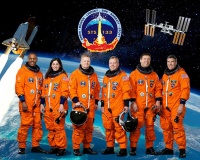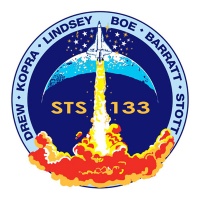STS-133
From The Space Library
 | |
| Organization | National Aeronautics and Space Administration (UnitedStates) |
|---|---|
| Mission type | Human Crew,Resupply/Refurbishment/Repair |
| Launch date | February 24, 2011 |
| Launch vehicle | Space Shuttle |
| Launch site | Cape Canaveral, United States |
| COSPAR ID | 2011-008A |
| Inclination | 51.6 degrees |
| Experiments | Here |
| Alternate Names | 37371 |
| Additional Information | Here |
| Data Collection | Here |
| Payload Mass Up | 14269.56 kg |
| Payload Mass Down | 1181.36 kg |
| Orbiter | Discovery |
| Lift Off Mass | 2,056,918.18 kg |
| Orbiter Weight at Liftoff | 122,100.00 kg |
| Orbiter Weight at Landing | 93,061.82 kg |
| Landed | 11:57 a.m. EST, concrete runway 15, Kennedy Space Center, Fla. |
| Orbits of Earth | 202 |
| Orbital Altitude | 190 nautical miles |
Contents |
[edit] Crew
- Commander: Steven W. Lindsey
- Pilot: Eric A. Boe
- Payload Commander:
- Mission Specialist 1: Benjamin Alvin Drew Jr.
- Mission Specialist 2: Michael R. Barratt
- Mission Specialist 3: Stephen G. Bowen
- Mission Specialist 4: Nicole P. Stott
[edit] Mission
STS 133 was launched from Cape Canaveral on 24 February 2011 at 16:53 UT. Shuttle Discovery docked with the International Space Station's (ISS) Harmony module on 26 February 2011 at 19:14 UT. The mission is the 39th and final flight of Discovery and the 133rd flight of the Space Shuttle program. STS 133 carried six astronauts. The primary goals of the shuttle mission are to deliver critical spare parts, supplies and a U.S. storage module to the International Space Station. Two key components carried in this mission were the Permanent Multipurpose Module (PMM), which is to be left permanently docked to one of the station's ports as a storage and research module, and the Express Logistics Carrier 4 (ELC4) which will provide spare parts and storage capacity to the orbiting complex. It also delivered Robonaut 2, which will become the first humanoid robot in space. Robonaut 2 will help NASA understand robotic capabilities for future deep space missions. The STS 133 mission includes several experiments that will be performed on the space shuttle Discovery and on the station during and after the shuttle mission. Discovery is scheduled to land at Kennedy Space Center 09 March 2011 at 16:57 UT.
[edit] EVA
Extravehicular Activity (EVA) conducted by Alvin Drew and Stephen Bowen during two spacewalks for a total of 12 hours, 48 minutes. EVA 1, 6 hours, 34 minutes; Drew and Bowen installed an extension cable in preparation for the installation of the PMM. They also installed a pump module vent tool, a camera wedge, and extensions to the mobile transporter rail. In addition, they relocated a tool stanchion and stored a failed pump module. Drew and Bowen also participated in the Japanese "Message in a Bottle" experiment by exposing a metal canister to capture the vacuum of space. EVA 2, 6 hours, 14 minutes; Drew and Bowen drained ammonia from an 800-pound pump module; worked on Dextre, the Special Purpose Dexterous Manipulator; installed a light on the CETA handcar; and repaired insulation on a radiator beam valve module.
[edit] Payload
ISS Assembly Flight ULF5; Permanent Multipurpose Module (PMM); ExPRESS Logistics Carrier 4 (ELC4); Robonaut2 (R2); the crew used the station and shuttle robotic arms to remove the ELC4 from Discovery's cargo bay and install it on the Earth-facing side of the ISS starboard truss, then to remove the PMM and install it on the Earth-facing port on the Unity node. Two days were added to the mission to allow the shuttle and ISS crews more time to unpack and set up the PMM.
[edit] Books about the Space Shuttle Program
Buy This Book Click here |
Buy This Book here |
Buy This Book Click here |
Buy This Book Click here |





